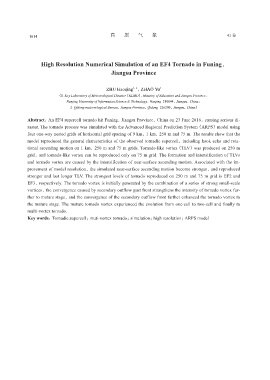Page 251 - 《高原气象》2022年第6期
P. 251
高 原 气 象 41 卷
1614
High Resolution Numerical Simulation of an EF4 Tornado in Funing,
Jiangsu Province
1,2
ZHU Haoqing ,ZHAO Yu 1
(1. Key Laboratory of Meteorological Disaster(KLMD),Ministry of Education and Jiangsu Province,
Nanjing University of Information Science & Technology,Nanjing 210044,Jiangsu,China;
2. Qidong meteorological Bureau,Jiangsu Province,Qidong 226200,Jiangsu,China)
Abstract:An EF4 supercell tornado hit Funing,Jiangsu Province,China on 23 June 2016,causing serious di‐
saster. The tornado process was simulated with the Advanced Regional Prediction System(ARPS)model using
four one-way nested grids of horizontal grid spacing of 9 km,1 km,250 m and 75 m. The results show that the
model reproduced the general characteristics of the observed tornadic supercell,including hook echo and rota‐
tional ascending motion on 1 km,250 m and 75 m grids. Tornado-like vortex(TLV)was produced on 250 m
grid,and tornado-like vortex can be reproduced only on 75 m grid. The formation and intensification of TLVs
and tornado vortex are caused by the intensification of near-surface ascending motion. Associated with the im‐
provement of model resolution,the simulated near-surface ascending motion become stronger,and reproduced
stronger and last longer TLV. The strongest levels of tornado reproduced on 250 m and 75 m grid is EF2 and
EF3,respectively. The tornado vortex is initially generated by the combination of a series of strong small-scale
vortices,the convergence caused by secondary outflow gust front strengthens the intensity of tornado vortex fur‐
ther to mature stage,and the convergence of the secondary outflow front further enhanced the tornado vortex to
the mature stage. The mature tornado vortex experienced the evolution from one-cell to two-cell and finally to
multi-vortex tornado.
Key words:Tornadic supercell;muti-vortex tornado;simulation;high resolution;ARPS model

